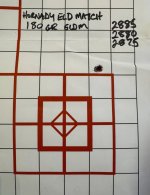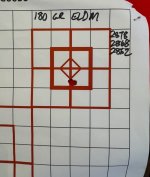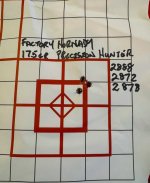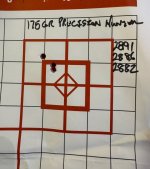I think that's just small sample size noise, they're going to vary from group to group to group. If you can fire 1/4" 3 shot groups very consistently with no impact variation, we are likely looking at the most accurate sporter/hunting rifle ever put together. I have zero doubts in your ability to shoot small groups WF, we have seen the proof on CGN for years.
I'd love to see ten 3 shot groups on a grid style target (easier to plot all the impacts into one combined group) of 57.7grs, and same with 56.8grs, which was your worst performing tested load. If the results prove that 56.8grs is 2-3x larger in group size / mean radius than 57.7, I will reimburse you the costs of the bullets and powder. I find this stuff really interesting and I do feel very fortunate that I can see detailed process/results done by others, as it only betters my understanding of handload development and the journey of finding repeatable results on target
Variation in ones ability to hand load consistently confirms your suspicion many times over, you are correct, my 7-6.5 PRCW is amazingly consistent but yes every so often a group will open up, so is it me or my handloads, but again I’m not sure I have ever loaded for a more consistent cartridge
I’m patiently waiting for my target rifle to be built.
I will do that test for you no problem.
When I go to the range to test rifles out I go to great lengths to have a very stable platform to shoot from so it I can see what the rifle can do with the least amount of human interference,
Since I have been using good brass, bushing dies and mandrels, the consistency has amazed me, but again every so often I can tell when I’m seating bullets I’m going to have a variation,
I have also noticed barrel to barrel differences, some barrels are finicky some not so much,
I’ll use the 7mm PRC cartridges for example
Same contour, length, twist, barrel maker,
I’ll use factory ammo for example as well as I usually break in barrels with it so lots of experience with different brands, I just buy it by the case to have on hand,
I have had 9 different 7mm PRCs built since its introduction, 3 steel barrels 2 Benchmark 1 KS Arms, the very first one built with a benchmark 1-8 twist loved any of the 3 factory Hornady ammo, the next Benchmark didn’t like any of it,

6 carbon fiber barrels 3 IBI 8.5 twist button rifled,,3 Benchmark 1-8 twist cut rifled,
Gary just built a 7mm PRC for a donation rifle with IBI barrel,
From the very first groups I shot with it it loved 180gr ELDM ammo shooting several cloverleaf and one hole groups, 175gr ELDX would shoot 3/4”
160gr CX would shoot 1 1/4”-1.5” two other rifles with the same IBI barrels one of them also loves the 180gr ELDM, the third one is exactly the opposite loving the 160gr CX but neither the ELDX/ELDM, same twist rate barrel lengths 1-8.5 at 22” length
Same thing with 6.5 PRC and the 300 PRC
There are so many variables just in the make up of the steel in a barrel let alone the rest of the elements of handloading to add to the picture.





 Then there’s 10s, with 120 unique 3 shot possibilities. Now you’re getting pretty close to knowing what that load actually does; and if it makes you feel better you can sort through and pick out all the random bragging groups you want. There’s bound to be some in the 2’s “when you do your part” , your part being to pick what you want to see,
Then there’s 10s, with 120 unique 3 shot possibilities. Now you’re getting pretty close to knowing what that load actually does; and if it makes you feel better you can sort through and pick out all the random bragging groups you want. There’s bound to be some in the 2’s “when you do your part” , your part being to pick what you want to see,










































































